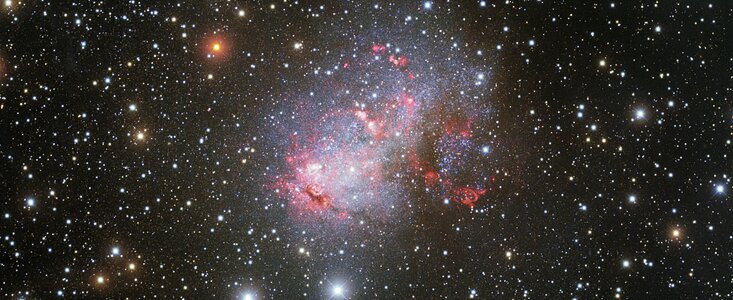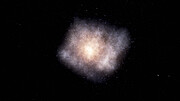Portrait of a Starburst Galaxy
KPNO captures irregular starburst galaxy IC 10 in glorious detail
18 June 2020
This striking image from NOIRLab’s Kitt Peak National Observatory (KPNO) presents a portrait of the irregular galaxy IC 10, a disorderly starburst galaxy close to the Milky Way. As well as a population of bright young stars, this irregular galaxy harbors exotic Wolf-Rayet stars and a black hole.
This image shows the disordered — yet beguiling — swirls of gas and stars that make up the irregular galaxy IC 10[1]. As the name suggests, IC 10 lacks the distinct regularity which makes stately spiral galaxies such as the Andromeda Galaxy and the Milky Way so striking. Instead, irregular galaxies like IC 10 have a more chaotic appearance — as can be seen from the unkempt red tendrils of stars and dust in this image.
IC 10 lies around 2 million light-years from Earth in the direction of the constellation of Cassiopeia. Though this distance seems huge, it puts IC 10 in the ever-growing Local Group of galaxies [2]. Not only is IC 10 relatively nearby, it’s also getting closer with each passing second — the galaxy is barreling towards the Milky Way at around 1.3 million kilometers per hour (780,000 miles per hour), nearly 500 times faster than a rifle bullet. Despite this headlong rush, IC 10’s crash course towards the Milky Way is nothing to worry about — the small irregular galaxy is a satellite of our neighbor Andromeda Galaxy and so it will not collide with our galaxy.
In addition to its proximity and breakneck speed, IC 10 holds the distinction of being a starburst galaxy — the only such galaxy in the Local Group. Starburst galaxies, as the name suggests, are those galaxies undergoing a fierce burst of star formation. These galaxies are replete with incandescent young stars, formed when gigantic clouds of cold hydrogen gas condense and reach the pressures necessary to ignite nuclear fusion. The luminosity of these newly formed stars is what makes the bright tendrils in this portrait of IC 10 so vivid.
As well as its hoard of young stars and vast hydrogen clouds, IC 10 harbors more exotic astronomical objects. The galaxy abounds with Wolf-Rayet stars, a rare class of star with extremely high surface temperatures. The surfaces of these stars can reach 200,000 degrees C (360,000 degrees F) — thirty times hotter than our Sun. As well as these blisteringly hot stars, IC 10 hosts a black hole — not as large as the supermassive monster at the heart of the Milky Way, but instead a much smaller black hole formed by the death of a massive star [3]. Intriguingly, our view of IC 10’s black hole is occasionally eclipsed. In much the same way that the Moon blocks sunlight during a lunar eclipse, an orbiting Wolf-Rayet star intermittently blocks the X-ray radiation from the black hole [4]. Chances are that IC10 has gone through a collision with another galaxy in the Local Group some 10 million years ago.
Despite its menagerie of fascinating astronomical objects and relative proximity, IC 10 has been steadfastly difficult to study since its discovery in the late 19th century. This difficulty is caused by the irregular galaxy’s location — it lies almost directly behind the thick band of stars and dust making up the Milky Way. These foreground stars can be seen as the bright points surrounded by diffraction spikes in this image. While these stellar interlopers may frustrate astronomers, they make a suitable frame for this striking portrait of an irregular galaxy.
This image was captured by astronomers at Kitt Peak National Observatory (KPNO), a program of NSF’s NOIRLab. KPNO sits in Arizona, USA, at an altitude of 2096 meters (6877 feet), and provides access to the northern hemisphere for US and worldwide scientific researchers.
Notes
[1] The name of IC 10, like many astronomical objects, comes from the catalog in which it was first described. Objects with the identifier IC were recorded in the Index Catalogue of Nebulae and Clusters of Stars, an extensive list of star clusters, nebulae, and galaxies discovered between 1888 and 1907. The sheer number of objects in the night sky leads to many objects — even galaxies as striking as IC 10 — not getting the catchy name they deserve.
[2] In 1935, Nicholas Mayall, director of Kitt Peak National Observatory, was the first to suggest that IC 10 may lie outside the Milky Way. A growing number of members of the Local Group of galaxies has been found over the years as observing equipment and technologies have improved.
[3] The supermassive black hole at the center of the Milky Way has a mass of approximately 4 million Suns. The black hole in IC 10 has a mass of approximately 30 Suns.
[4]The companion star of IC 10’s black hole is both the source of these X-rays and their occasional occlusion. Material stripped from the surface of the Wolf-Rayet star spirals onto the black hole, where it reaches enormously high temperatures and radiates energy outwards as X-rays. As the orbiting star passes between the black hole and Earth, this stream of X-ray radiation is temporarily interrupted.
More information
NSF’s NOIRLab (National Optical-Infrared Astronomy Research Laboratory), the US center for ground-based optical-infrared astronomy, operates the international Gemini Observatory (a facility of NSF, NRC–Canada, ANID–Chile, MCTIC–Brazil, MINCyT–Argentina, and KASI–Republic of Korea), Kitt Peak National Observatory (KPNO), Cerro Tololo Inter-American Observatory (CTIO), the Community Science and Data Center (CSDC), and Vera C. Rubin Observatory (in cooperation with DOE’s SLAC National Accelerator Laboratory). It is managed by the Association of Universities for Research in Astronomy (AURA) under a cooperative agreement with NSF and is headquartered in Tucson, Arizona. The astronomical community is honored to have the opportunity to conduct astronomical research on Iolkam Du’ag (Kitt Peak) in Arizona, on Maunakea in Hawaiʻi, and on Cerro Tololo and Cerro Pachón in Chile. We recognize and acknowledge the very significant cultural role and reverence that these sites have to the Tohono O'odham Nation, to the Native Hawaiian community, and to the local communities in Chile, respectively.
Contacts
Amanda Kocz
Press and Internal Communications Officer
NSF’s NOIRLab
Cell: +1 626 524 5884
Email: akocz@aura-astronomy.org





